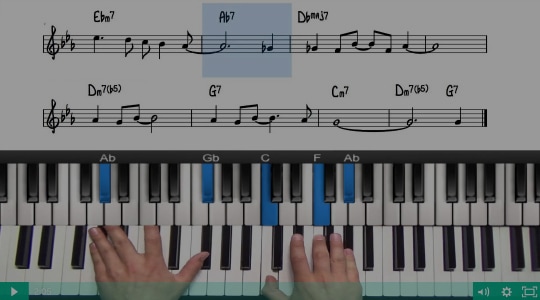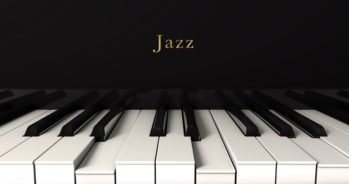I received the questions below from one of our [PianoGroove](https://www.pianogroove.com/join/) students, and I thought it would be nice to post the answer here on this page. I share a lot of insight from my journey learning jazz piano, and I think you will benefit from reading it…
***Student’s question:***
> I was wondering if you could do a tutorial on your approach to practicing when you were learning to be a jazz pianist. What did you learn first? Did you have a system or a list of songs? Did you use a metronome? How often did you practice 251s and how long did you practice per day?
>
> I feel like I have plateaued and my practice seems less effective now. I believe this type of tutorial could change the landscape for many of your students if they understood your approach.
Here’s my answer:
#### What did you learn first? Did you have a system or a list of songs?
The PianoGroove syllabus very closely mirrors my own journey learning jazz piano, both in terms of the theory lessons and the jazz standard lessons.
The first tunes I learnt were:
* Tune Up
* Misty
* Tenderly
* My Foolish Heart
* Blue In Green
(Bill Evans was my first big influence, and so that’s why I wanted to work on My Foolish Heart & Blue In Green)
At the time, I was working with my first jazz teacher and he was showing me how he would arrange standards and I would simply copy what he was playing and ask questions on what I didn’t understand.
He played lots of things which I didn’t fully understand at the time (such as upper structures, slash chords, altered jazz chords etc…) but I still emulated the way he created arrangements from lead sheets and did this for many tunes.
I studied with him for around 2 years, and by the end of that time, I was comfortable with voicings but I still couldn’t create my own arrangements from scratch.
A key part of my early jazz education was that I was learning in the context of jazz standards. This made it enjoyable and rewarding because I could play jazzy sounding arrangements for my friends and family. This is why I give such importance and emphasis on jazz standards in the [PianoGroove syllabus](https://www.pianogroove.com/join/) to make it a fun and enjoyable learning experience.
From playing 000s of jazz standards… I can now pick up a lead sheet for the first time, and play something that sounds nice. But if I learn a new tune, I will always use it as an opportunity to learn some new theory (see my last paragraph about listening and picking things off records).
You will see lots of similarities in jazz standards the more you tunes you learn. They often follow very similar chord progressions, and the more you play, the easier you will be able to spot these similarities.
#### Did you use a metronome?
In some ways, I wish I paid more attention to this.
As a solo jazz pianist, you have a lot of freedom because you are playing by yourself. We can play rubato, and drift out of time here and there, and what we are playing can still sound very pleasant to the listener.
However, when I started to play with other musicians, I then had a big shock in store because I couldn’t keep time. If you are playing jazz with other musicians, then the only thing that keeps everyone together is the time.
It’s worth mentioning that the types of tunes I was playing with other musicians were different to the types of tunes I had already learnt. Virtually all of my first tunes were ballads and all very well suited to solo piano performance. Whereas the tunes that you play with other musicians at a jazz jam setting tend to me medium/up tempo. Think of tunes we have covered such as Autumn Leaves, Beautiful Love, There Will Never Be Another You, to name a few examples.
This is when I started to play more with iRealPro.
My course on “Playing In A Jazz Band” documents much of my journey and learnings with regards to playing in a band.
Back to your question… no, to start with I didn’t use a metronome. If I could take my journey again, I would place more of an emphasis on this.
That is also talking hypothetically because at the time, my aspiration was to be able to play solo jazz piano as a background pianist. As discussed, being perfectly in time was not essential and I could take liberties by playing rubato and interpreting the lead sheets more freely.
A lot of this will boil down to your own aspirations. What are your own goals with playing jazz? That’s an important place to start.
#### How often did you practice 251s?
I’d probably been working on 251s for about 1.5 years before I even started with my first teacher. When I started studying with the teacher I could play most major 251s – albeit sometimes it would take me a while to find the voicings! – but I could see them on the piano, I could see the 7ths falling to 3rds. I could play them in the 3 note variation and also playing major/minor 9ths, and dominant 13s (basically left hand voicings but in my right hand with the root in my left hand).
Even to this day, I still work on 251s. But instead of drilling them, I pick up a new jazz standard and i’ll play through with left hand voicings and the melody. If there’s a 25 or 251 on the lead sheet, and it takes me more than a second to find the voicing, then I will take it away and drill it. This might be due to the chords that come before or after, or perhaps an unusual melody note that makes it tricky to voice to 251.
Once you understand the construction of the 251, I would recommend that you follow a similar approach. This way you are working on the 251s that you don’t know, or the ones that could be a little more comfortable under your fingers.
I see this as a much more effective way to improve as opposed to repetitive 251 drills on the keys that I am already completely familiar with. Again this ties into the importance of using jazz standards as a vehicle to take your playing forward.
251s are a lot of work. You will always be able to get better at them, find the voicings quicker, play them more smoothly, play them without looking etc… this is a gradual process that happens over many years. The important thing is that you understand the theoretical underpinnings and then we can move on and revisit them on a per-key basis. For example, if you stumble across an unfamiliar 251 key in a jazz standard.
#### How long did you practice per day?
In terms of daily practice, I would say at least 2 hours a day. Sometimes much more, sometimes slightly less. But I’d say at least 2 hours is a good amount of time to aim for.
I don’t know exactly where you are in your journey, but my biggest recommendation would be to listen more and try to pick things off records.
Whenever I create a new arrangement for PianoGroove, here’s the process I follow:
* Pick a tune
* Listen to as many different recordings as possible
* Create a shortlist of tunes that I like the sound of
* Then, and only then, I try and play the tune from a lead sheet. I already have the melody ingrained from the listening stage, and so it makes the task much easier.
* I will listen to the shortlist, and anything I like the sound of, I will try to work out with my ears. This is a slow process and takes time and patience. Using transcription tools like Transcribe can make the process much easier. The more you do it, the less you will need transcription tools. Now I can hear very specific things such as a Sus chord to an altered dominant in a 251… my ears will recognise that with the click of a finger. I can hear specific alterations over dominant chords such as b9s #11s… my ears know what they sound like because I’ve spent lots of time listening. I can hear diminished sound and patterns, I can hear chromatic passing chords with the distinctive half step approach. I can hear many things even the first time listening to a record. This is all from the time I have invested in listening.
#### Lessons with Teachers vs Listening to Records
When you work something out yourself, you will retain the information better, and you will think of that thing – whatever it is – next time you have a similar chord or similar situation on a lead sheet.
This is why listening is so important. Don’t get me wrong, working with a teacher and copying them and emulating them is one of the quickest ways to improve. You will learn things in minutes that may have taken you years – sometimes if ever! – to figure out just by working on your own.
That being said, there has to be a point in your journey when you become a self sufficient learner ie. learning predominantly from recordings.
That’s what jazz is all about, discovering the sounds you like, imitating them, and then making your own sound which is a culmination of everything you have listened to.
I will occasionally get a lesson or 2 with accomplished musicians who’ve been studying jazz for 2x or 3x longer than me. But most of my time is spent listening to the artists, albums, and recordings that I personally enjoy listening to. That way I am in complete control of the direction of my sound.
You will also find you can learn a tonne of things from playing with other musicians. At a jazz jam night for example. You might be chatting to someone and they will introduce you to their inspirations, you might be talking about some kind of theoretical concept etc… and making friends with these people and collaborating with them is a fantastic way to learn.
Again a lot of this boils down to your aspirations, and what you want to do with jazz.
For myself, a big area I’ve been working on is playing with other musicians. I love solo piano, and for sure there’s lots more I can do to further my playing in the area, but I have a strong desire to improve at playing with other jazz musicians.
Sometimes I’ll play with really talented players and I’ll get frustrated because I wish I could play better in that setting.
Unless you are at the point of complete mastery, which for most people with other commitments (work, family etc…) I’d estimate that would be 30-40 years of studying jazz. Then you will always feel this frustration. It’s natural because the topic is so vast and there is always more to learn. Always something to work on.
I find the key is to accept that, keep studying, and get a little bit better each day.
It’s supposed to be fun after all! 🙂
What About You?
Would you like to see how PianoGroove can help you “get a little better each day” and work up to being able to “play awesome jazzy sounding arrangements for friends and family”?



